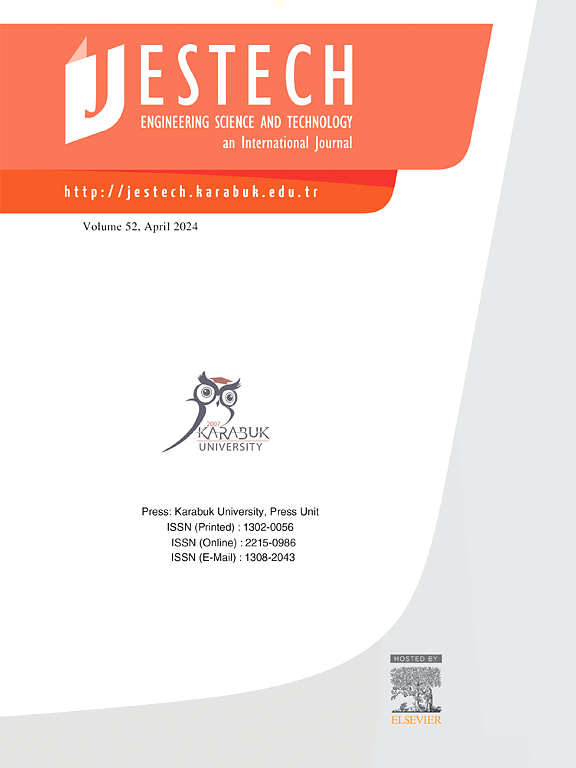Discovering temporal, spatial, and contextual anomalous social activities from streaming social media datasets
IF 5.1
2区 工程技术
Q1 ENGINEERING, MULTIDISCIPLINARY
Engineering Science and Technology-An International Journal-Jestech
Pub Date : 2025-03-08
DOI:10.1016/j.jestch.2025.102006
引用次数: 0
Abstract
Social media data refers to data collected from social media platforms, including user interactions, posts, comments, likes, etc., while streaming social media data is a specific type of social media data that is continuously and sequentially collected from these platforms. Processing of streaming social media data is crucial for providing quick responses and reacting promptly to issues. Therefore, it requires more specialized solutions compared to traditional social media data processing algorithms. Temporal, spatial, and contextual anomalous social activity of a social media user can be defined as activities of sending a frequent and abnormal number of posts that are contextually similar to other posts in a time frame and at specific locations. However, detecting anomalies in streaming social media datasets has many difficulties due to the size, continuous increase, different characteristics (e.g., temporal, spatial, and contextual) of the data, and shortcomings of existing algorithms to handle streaming social media datasets. In the literature, many studies are conducted on detecting anomalies in social media data or streaming data. Nonetheless, anomaly detection studies on streaming social media datasets are very limited. The focus of this study is the detection of temporal, spatial, and contextual anomalous social activities from streaming social media datasets. In particular, streaming Twitter/X dataset is analyzed in terms of three different aspects, such as temporal, spatial, and contextual anomalous social activity detection. The proposed Temporal, Spatial, and Contextual Anomalous Social Activity Miner (TSCASA-Miner) algorithm is experimentally evaluated with a naive alternative and related studies. Evaluations are conducted using a real-life streaming Twitter/X dataset from New York, USA. The results demonstrate that the proposed TSCASA-Miner algorithm outperforms the other algorithms, with a recall of 0.93, a precision of 0.95, and an accuracy of 0.9323, marking an improvement of 0.018 in accuracy.
求助全文
约1分钟内获得全文
求助全文
来源期刊

Engineering Science and Technology-An International Journal-Jestech
Materials Science-Electronic, Optical and Magnetic Materials
CiteScore
11.20
自引率
3.50%
发文量
153
审稿时长
22 days
期刊介绍:
Engineering Science and Technology, an International Journal (JESTECH) (formerly Technology), a peer-reviewed quarterly engineering journal, publishes both theoretical and experimental high quality papers of permanent interest, not previously published in journals, in the field of engineering and applied science which aims to promote the theory and practice of technology and engineering. In addition to peer-reviewed original research papers, the Editorial Board welcomes original research reports, state-of-the-art reviews and communications in the broadly defined field of engineering science and technology.
The scope of JESTECH includes a wide spectrum of subjects including:
-Electrical/Electronics and Computer Engineering (Biomedical Engineering and Instrumentation; Coding, Cryptography, and Information Protection; Communications, Networks, Mobile Computing and Distributed Systems; Compilers and Operating Systems; Computer Architecture, Parallel Processing, and Dependability; Computer Vision and Robotics; Control Theory; Electromagnetic Waves, Microwave Techniques and Antennas; Embedded Systems; Integrated Circuits, VLSI Design, Testing, and CAD; Microelectromechanical Systems; Microelectronics, and Electronic Devices and Circuits; Power, Energy and Energy Conversion Systems; Signal, Image, and Speech Processing)
-Mechanical and Civil Engineering (Automotive Technologies; Biomechanics; Construction Materials; Design and Manufacturing; Dynamics and Control; Energy Generation, Utilization, Conversion, and Storage; Fluid Mechanics and Hydraulics; Heat and Mass Transfer; Micro-Nano Sciences; Renewable and Sustainable Energy Technologies; Robotics and Mechatronics; Solid Mechanics and Structure; Thermal Sciences)
-Metallurgical and Materials Engineering (Advanced Materials Science; Biomaterials; Ceramic and Inorgnanic Materials; Electronic-Magnetic Materials; Energy and Environment; Materials Characterizastion; Metallurgy; Polymers and Nanocomposites)
 求助内容:
求助内容: 应助结果提醒方式:
应助结果提醒方式:


